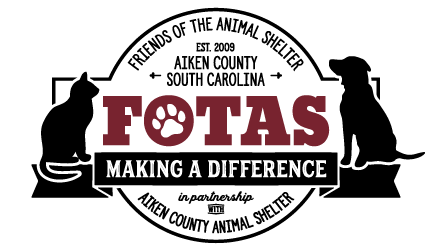31 May 2015

By Joanna Dunn Samson, FOTAS Vice President
5000 square feet. Concrete floors with open trenches for waste removal. No air conditioning or air exchange system. No isolation facilities. No medical facilities. A tiny food prep area. No hot water. Peeling paint. Inadequate lighting. No separate cat facilities. No play yards. No volunteers. 200 anxious animals stuffed into a facility designed for 50.
It was a prescription for misery. Chance of survival at the old Aiken County Animal Shelter? About 10-15%.
Bobby Arthurs, the County’s Chief Animal Control Officer who started working with enforcement in 2001, remembers those days.
“It was hard at the old shelter,” says Arthurs, “especially in the spring and summer months when intake was so high and we’d have 3 or 4 animals crowded together in a single, small kennel. There were no volunteers or staff to walk or play with them. You’d look over the room and it was like the animals had just given up – they were all depressed.”
In those days, the shelter was overcrowded and the euthanasia rate was still 85-90% on average. A trip to the shelter was a near-certain death sentence for an animal. Often the only time an animal had any personal human contact was when they were removed from their cage to be euthanized.
All that changed when the new shelter opened last year.
“Now the shelter can separate adoptable animals from intake animals,” says Arthurs. “We have hot water, proper ventilation, sanitary medical facilities. We can isolate sick animals – that’s huge! Finally, shelter staff has the ability to improve the prospects for these animals.”
Sandy Larsen, the senior vet tech at the shelter who shares the distinction with Arthurs of having worked at the shelter the longest, agrees.
“It’s a happier, healthier place to be for everyone,” says Larsen, “staff, animals and volunteers – and as a result, our adoptions are up, our transfers are up, and our euthanasia rate is down. In fact, I can’t remember the last time we had to euthanize an animal from the adoption floor.”
I wish we could say, “It’s all better!” and rest on our laurels, but we can’t. The success over the past year is fragile and dependent on so many factors: the amount of intake, proper staffing, sufficient public funding, and volunteers. Some of those are already in question.
Our volunteer force is down dramatically because of folks leaving for the summer. One morning last week, only one person was available to walk 30 dogs.
April and May have seen record intake highs.
The County budget is strained because of reduced state and federal funding and the expenses of last year’s ice storm.
Although the Aiken community has demonstrated its support, both in commitments of time and money, to turn the shelter around, the job is not, perhaps will never be, done. Success requires resources.
Now, more than ever, we need volunteers at the shelter to walk dogs and help around the shelter. We need foster families to take animals slated for transfer out of the shelter to help alleviate overcrowding. We need all citizens to spay and neuter to reduce the overpopulation of homeless animals. We need donations to take care of special needs at the shelter.
We need you, the Aiken community, to tell your friends, your neighbors, and your elected officials how much the community shelter means to you.
And if you can, we need you to give these animals a home.


